The Power of Data Visualization
Organizations are leveraging data to improve all aspects of business. Many industries are adopting a data-driven mindset to make better business decisions, personalize the customer experience, and enhance products. Even non-technical industries, like fashion and sports, are finding unique ways to incorporate data into their products and operations.
The quantity of available data is massive. Nearly every action in a business can be tracked, analyzed, and improved. However, how we translate big data into actionable insights is still a work in progress.
In its raw form, data is not very useful to business leaders seeking actionable conclusions. Traditionally, businesses addressed this issue by organizing data into tables and spreadsheets. Instead of digging through hours of code or physical surveys, people could analyze specific data points compiled neatly into a spreadsheet.
While these traditional reporting methods were an improvement over digesting raw data, there are several pitfalls spreadsheets and tables can’t address effectively. This leads us to another turning point in data interpretation, the rise of data visualization.
Data visualization is a graphical representation of information and data. It uses visual elements like charts, graphs, and maps, to provide an accessible way to see and understand trends, outliers, and patterns in data.
What are the Advantages of Visualization Techniques Over Traditional Techniques?
Data visualization techniques offer a powerful new way to communicate data-driven insights. Let’s walk through a few of the advantages.
Visualizations Make It Easier to Interpret Data
65% of the world’s population are visual learners. That’s nearly 4 billion people who naturally prefer visualization as their primary method of learning. By simply incorporating visualization into your data strategy, you are already improving communication for over half of your business.
Charts, bar graphs, and images are also easier to interpret because they allow us to see the context around a specific point of interest. In contrast, tables and spreadsheets only show us static data points. Rarely do people come to conclusions without wanting to understand the context surrounding the data. We want to know why because it helps us draw fully-informed conclusions that lead to rationally-based decisions.
Ease of interpretation also helps ensure valuable insights don’t get lost in translation. Business leaders have limited time. Quick reviews of reports can lead to misleading conclusions if key insights are not immediately clear. The skimmability of visuals helps ensures decision makers receive valuable data accurately and efficiently.
Visualizations Are Quick
Visualizations are quick to interpret which is a huge advantage in face-paced markets. For example, a manager can quickly compare and identify a gap in his employees’ skill set by using a bar graph like the one below:
How long did it take you to spot the deficiency? Half a second? Now, imagine trying to spot that same deficiency in an excel table with each individual score from every team member and managers on the development team. Probably, not going to be as quick.
The advantage of speed allows the manager to focus more time on developing solutions to the problems revealed by the data. Adopting techniques that create more time for high-value tasks is key to producing internal efficiencies and operational success.
Interpret Large Quantities of Data Efficiently
Speaking of operational efficiencies, visualizations allow us to review large quantities of data in a single instance. Statistically, larger sample sizes provide more reliable results. Business leaders need both this reliability and efficiency from their data in order to make effective, timely business decisions.
Let’s go back to the example above. Our manager needs to compare every skill across his entire team to determine where he needs to apply additional training. By using the bar graph below, he is able to analyze a large amount of data instantly:
Without using the graph to express the data in a consumable form, he would have to sift through rows of data points to identify the areas of weakness. Unfortunately, this means he spends more time trying to identify gaps and less time developing a solution that improves his team’s performance.
In order to capture the full benefits of big data, we need to use techniques that allow us to leverage large datasets without sacrificing valuable time dedicated to high-value tasks.
Visualizations Help Us Recognize Patterns and Anomalies
Visualizations offer an easy way to identify patterns and anomalies in data. We can quickly recognize trends over time, consistencies across groups, and strange outliers. Oftentimes business leaders draw conclusions on these patterns, trends, and anomalies instead of on specific data points. For instance, if you were looking to expand into a new market, you would analyze the overall market trends to weigh your possibility of success.
Data visualization is the most efficient, clear, and easy way to communicate key insights in data. Visualizations don’t need to be complex to be effective. Simple bar graphs or line charts can be powerful tools for interpreting data as long as key insights are communicated clearly. While traditional techniques should be utilized to collect and organize data, consider leveraging visualization techniques to better understand and communicate your findings to decision makers.
Ready to invest in the future of your workforce?
Learn how Visual Workforce can help you discover and optimize the skills and capabilities of your people, teams, and projects.










